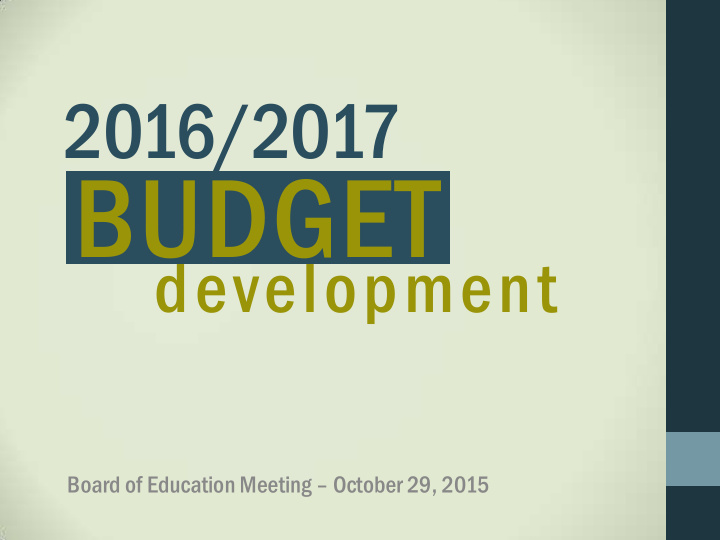



2016/2017 BUDGET development Board of Education Meeting – October 29, 2015
Plan Overview Timeline Objectives Process Schools – Second year of Student Based Budgeting (SBB) Departments – Implement new process Budgeting for Outcomes (BFO)
Timeline November Governor’s Proposed Budget December Kick off School (Student Based Budgeting) and Department (Budgeting for Outcomes) Processes January/February Community Engagement March Build Budget April March Forecast; Fine Tuning of Budget May Budget Adoption
Jeffco Budget Objectives The Budget will: Effectively allocate monetary resources to enhance student achievement. Clearly communicate the financial state of the district to the public. Comply with all state, federal and local statutes and regulations as well as internal organizational controls. Identify all budgetary changes from year to year. Set appropriations to ensure positive reserve balances in all funds. Pg. 23 – Jeffco 2015/2016 Adopted Budget
The Process will continue to: Meet specified deadlines while producing a comprehensive and accurate budget. Provide opportunities for community and staff input to support Board budget direction. Identify budget assumptions used for the development process. Use forecasting to anticipate future needs and resources. Review all program and department budgets. Pg. 23 – Jeffco 2015/2016 Adopted Budget
Two-part Process For Schools Entering second year of Student Based Budgeting (SBB) For Departments Implementing a new process Budgeting for Outcomes (BFO) These processes work in unison to better align the district’s budget with its strategic plan and long term financial plan.
STUDENT BASED budgeting Process for Schools
Background Implemented for majority of schools for the 2015/2016 school year. This model: Allocated resources to schools based on their Allocated resources to schools based on their student counts and factors such as at-risk. student counts and factors such as at-risk. Directed funds to schools in support Directed funds to schools in support of school-based decision-making . of school-based decision-making . Provided equity as funds were allocated Provided equity as funds were allocated in a uniform and consistent process based in a uniform and consistent process based on the population each individual school on the population each individual school serves. serves. Provided flexibility for site-based decisions Provided flexibility for site-based decisions for staffing and spending within limited for staffing and spending within limited parameters known as defined autonomy. parameters know as defined autonomy.
SBB for Schools - Update First Year Accomplishments Implementation involved over 130 sites Training and support were instrumental in the successful roll out of SBB Results and feedback were positive A recent survey of principals showed that over 70 percent view SBB as an improvement from the prior central allocation model.
Second Year Goals Continue with process Fine tune factors – shifting of revenue Gather enrollment data Include benefits in planning process
budgeting for OUTCOMES Process for Departments
Budgeting for Outcomes (BFO) After research and careful consideration, the Budget staff believes using BFO, a modified priority based budgeting approach, for departments will yield greater results than any of the other models. Better aligns our processes with the Board’s ends, strategic planning goals and long term financial plan. Creates a departmental process that supports SBB. Promotes efficiencies and presents a focus on the district’s already established goals. Enables the district to continually evaluate the success of achieving defined goals.
BFO Objectives The key objective of BFO is to understand our community’s values and create a budget to reflect those values. Other objectives of BFO: Budgeting priorities change with changes in the strategic plan. Focuses on programs that directly contribute to the success of the strategic plan. Takes in to consideration future needs of the district.
Research on Budgeting Methods The district researched various budgeting strategies, including: Zero-Based Budgeting Budget starts from zero. Each department submits decision packages on levels of service. Hundreds of decision packages require significant time commitment from all levels of management. Managers are reluctant to suggest packages below current spending. Managers are focused on decisions packages and do not look at how to change services. Ranking of intangible outputs can be difficult. Current budget staff resources are inadequate to fully implement this process.
Other districts have been cited as purportedly using the zero based budgeting model. After digging deeper, the majority of these sources were actually using a modified or hybrid approach to ZBB or still using incremental budgeting. The Government Finance Officers Association (GFOA) found only 2 out of 413 governments using a textbook version of ZBB.
“The white paper. . . will focus on how Fulton launched a modified zero-based budgeting process for FY 2014 aligned to strategic goals while still coming in $17 million under the previous year’s budget – all without making any budget cuts.”
Financial structural issues – Burlington (VT) as of October 2014, still School District researching a budgeting model. Currently using Ann Arbor incremental budgeting . School District Currently using Oakland a modified student based School District budgeting model.
Other budgeting methods researched: Target Program Based Review Budgeting Research shows this Research shows approach requires an this approach does not additional level of effort comprehensively beyond the budgeting examine spending process, by looking and leaves fewer specifically at how a options for decision program is provided. makers.
Phased Implementation Staff plans to implement the Budgeting for Outcomes process using a phased approach: Clearly identify priorities of the district based on community values. Identify key departments to take place in the first wave of implementation. Team with Government Finance Officers Association (GFOA) for implementation assistance that it offers to districts. Join with the Alliance for Excellence in School Budgeting to gain access to tools and networking opportunities surrounding Best Practices in School Budgeting program.
Budgeting for Outcomes aligns with STUDENT BASED BUDGETING Manageable aligns with existing staff and OUR PROCESSES resources with BOARD STRATEGIC LONG ENDS PLANNING TERM GOALS FINANCIAL PLAN
Questions
Recommend
More recommend